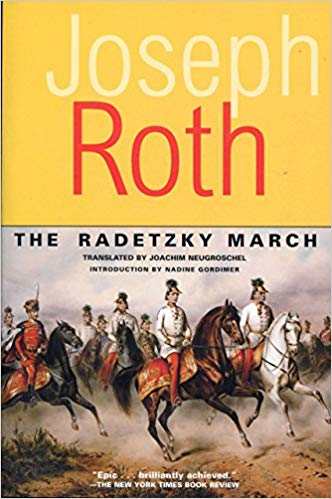Our book group choice for February 2020 is The Radetzky March by Joseph Roth. The Radetzky March charts the history of the Trotta family through three generations spanning the rise and fall of the Austro-Hungarian Empire.
The Radetzky March is a 1932 novel by Joseph Roth that tells the story of three generations of the Trotta family, professional Austro-Hungarian soldiers and career bureaucrats of Slovenian origin, from their zenith during the empire to the nadir and breakup of that world during and after the First World War.
The novel opens with the Battle of Solferino in 1859, where Joseph Trotta, a Slovenian peasant, saves the life of the Emperor Franz Joseph I. For this act of bravery, Trotta is ennobled and given the title of Baron. Trotta’s son, Franz, is raised in the shadow of his father’s heroic act, and he joins the army in the hope of following in his footsteps. However, Franz is a sensitive and idealistic young man, and he finds it difficult to adjust to the harsh realities of military life.
Franz’s son, Carl Joseph, is the last member of the Trotta family to serve in the army. Carl Joseph is a brilliant and talented officer, but he is also deeply disillusioned with the empire. He sees the corruption and decay that have taken root in the military, and he comes to believe that the empire is doomed.
The Radetzky March is a sweeping historical novel that tells the story of the decline and fall of the Austro-Hungarian Empire. However, it is also a deeply personal novel that explores the inner lives of the Trotta family. Roth’s writing is lyrical and evocative, and he creates a vivid portrait of a world that is both familiar and alien.
The novel is narrated by Carl Joseph Trotta, and it is through his eyes that we see the empire in its final days. Carl Joseph is a complex and sympathetic character, and his journey from idealism to disillusionment is both heartbreaking and ultimately redemptive.
The Radetzky March is a powerful and moving novel that offers a unique perspective on the end of an empire. It is a story of loss, but it is also a story of hope. Roth’s novel reminds us that even in the darkest of times, there is always the possibility of redemption.
Discussion Questions for The Radetzky March
- How do the Radetzky March (the piece of music) and the portrait of the Kaiser function as recurring symbols through the course of the book?
- What is the relationship between portraits and their subjects: Trotta1 and the portrait painted by his son’s friend? The Kaiser himself and his ubiquitous likeness — or particular copies of that likeness? What about Trotta1 and the misleading historical portrait in the children’s reader that sets him off?
- Is the particular reason for Trotta1’s elevation important to the meaning of the book or the trajectory of his family’s decline? How about his rage over being misrepresented in the schoolbook?
- Would you attribute the dissipation of the Trottas over three generations to their entanglement in the declining empire of which they are a part? or to the characters of the three men? or to particular family dynamics? To what extent can you separate those factors?
- Does Roth’s portrayal of the plight of the third generation resonate outside the particular circumstances of the decline of the Austro-Hungarian Empire?
- What is the effect of the shifts in Roth’s narrative style from the early chapters to the body of the book focused on Trotta3, and then from one section of the novel to the next? What do you make of the differences in style between this book and The Leopard?

